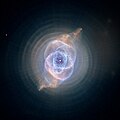English: This phantasmagorical sculpture of gas and dust gives one the feeling of observing a series of explosions deep under the surface of a clear body of water. Caldwell 6, also known as NGC 6543 and commonly called the Cat’s Eye Nebula, is as well known as it is enigmatic. Hubble’s stunning image of this remarkable object has garnered fame for both the telescope and the nebula.
Caldwell 6 is a planetary nebula — clouds of expanding gas given off by an aging star during its slow death. When a star gets old and its hydrogen fuel runs out, its core collapses and its outer layers puff up. As the collapsing core gets hotter and denser, helium fusion ignites and produces an outward rush of energy that pushes the outer layers of gas into space, forming a nebula. This cycle can repeat, creating a series of gaseous rings around the central star, as Hubble revealed in the Cat’s Eye Nebula.
Planetary nebulas are so named because their rounded shapes looked like planets to the first astronomers who viewed them through telescopes. Caldwell 6 was discovered in February of 1786 by German-British astronomer Sir William Herschel (who also discovered the planet Uranus and was knighted in 1816). English amateur astronomer William Huggins is credited with investigating Caldwell 6’s spectrum for the first time, and his studies demonstrated that planetary nebulas are gaseous in nature, rather than stellar or otherwise, as previously thought.
In addition to being one of the first planetary nebulas discovered and the first to be observed spectroscopically, the Cat’s Eye Nebula is (for reasons unknown) also one of the most complex ever observed. This image, captured by Hubble’s Advanced Camera for Surveys in 2002, reveals the nebula’s complexity, including concentric gas shells, jets of high-speed gas, and unusual shock-induced knots of gas. Each of the eleven or more concentric rings, or shells, around the Cat's Eye is actually the edge of a spherical bubble seen projected onto the sky — material ejected in regular episodes 1,500 years apart and forming a layered, onion-skin structure around the dying star.
Hubble’s image of it evokes feelings of a dramatic and swift eruption, but in reality, planetary nebulas reflect the very slow death of a Sun-like star — an alternative to violent supernova explosions. This exquisite stellar demise provides scientists the opportunity to study how the chemicals that were previously encased in the star disseminate into the universe and eventually influence the creation of new stars and planets — and perhaps life.
The Cat’s Eye has one of the highest surface brightnesses in the Caldwell catalog. Despite its relatively small size (just 5 light-years across), it still manages an impressive magnitude-8.2 apparent brightness. Located about 3,000 light-years away, Caldwell 6 is located in the constellation Draco and is best seen during the summer in the Northern Hemisphere. Southern Hemisphere observers might be able to spot it in mid-winter if located close to the equator. The nebula’s small size will make it difficult to see in detail, but its high apparent magnitude will help observers spot it with a telescope. After locating Caldwell 6, try using “averted vision,” or looking away from the center of the nebula, to better see the billowing clouds of gas.
Credit: NASA, ESA, HEIC and the Hubble Heritage Team (STScI/AURA); Acknowledgment: R. Corradi (Isaac Newton Group of Telescopes, Spain) and Z. Tsvetanov (NASA)
For more information, visit: hubblesite.org/contents/news-releases/2004/news-2004-27.html
hubblesite.org/contents/news-releases/1995/news-1995-01.html
For Hubble's Caldwell catalog site and information on how to find these objects in the night sky, visit: XXX

